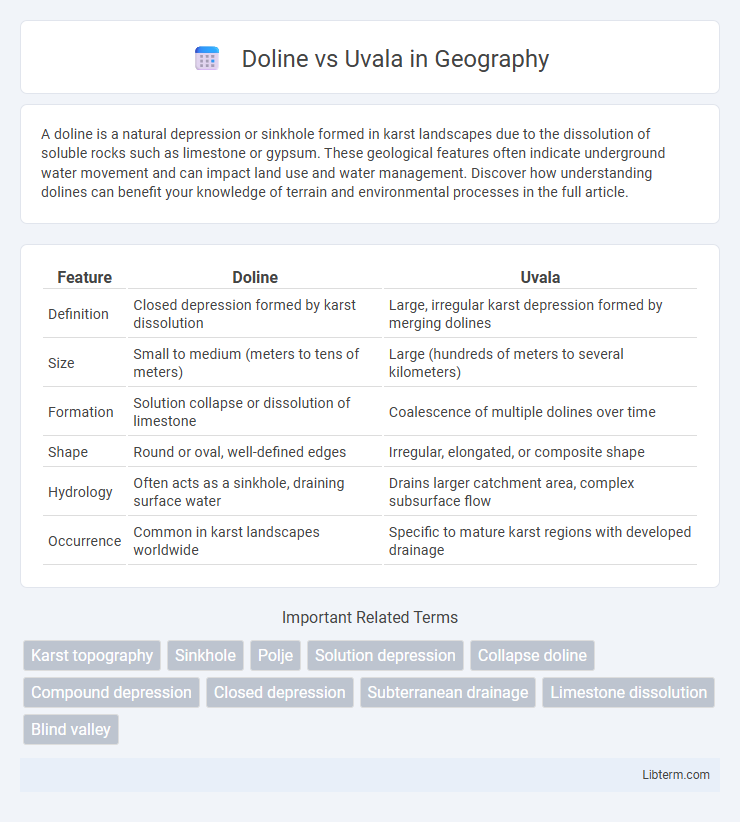A doline is a natural depression or sinkhole formed in karst landscapes due to the dissolution of soluble rocks such as limestone or gypsum. These geological features often indicate underground water movement and can impact land use and water management. Discover how understanding dolines can benefit your knowledge of terrain and environmental processes in the full article.
Table of Comparison
| Feature | Doline | Uvala |
|---|---|---|
| Definition | Closed depression formed by karst dissolution | Large, irregular karst depression formed by merging dolines |
| Size | Small to medium (meters to tens of meters) | Large (hundreds of meters to several kilometers) |
| Formation | Solution collapse or dissolution of limestone | Coalescence of multiple dolines over time |
| Shape | Round or oval, well-defined edges | Irregular, elongated, or composite shape |
| Hydrology | Often acts as a sinkhole, draining surface water | Drains larger catchment area, complex subsurface flow |
| Occurrence | Common in karst landscapes worldwide | Specific to mature karst regions with developed drainage |
Introduction to Karst Landscapes
Doline and uvala are key features of karst landscapes, formed by the dissolution of soluble rocks like limestone. Dolines are small, bowl-shaped depressions created by localized collapse or chemical erosion, while uvalas are larger, irregular depressions formed by the merging of multiple dolines. These landforms indicate the dynamic processes of karstification, revealing the subsurface drainage and geological evolution in karst regions.
Defining Doline: Features and Formation
A doline is a common karst landform characterized by a closed, circular depression formed primarily through the dissolution of soluble rocks such as limestone, leading to subsidence or collapse. These depressions often vary in size from a few meters to hundreds of meters in diameter and depth, exhibiting steep sides and a typically bowl-shaped profile. Doline formation is driven by chemical weathering processes, groundwater erosion, and the collapse of underground voids, distinguishing them from larger karst features like uvalas.
Understanding Uvala: Characteristics and Development
Uvalas are larger karst depressions formed by the coalescence of multiple dolines, exhibiting elongated or irregular shapes with more complex drainage patterns. They develop over extended geological time through the progressive merging and deepening of dolines, often indicating advanced stages of karst landscape evolution. Understanding uvalas provides insight into subsurface hydrology and regional geomorphological processes in karst environments.
Key Differences Between Doline and Uvala
Doline and uvala are distinct karst landforms with key differences in size and formation processes; dolines are small, closed depressions formed primarily by solution or collapse, typically measuring from a few meters to several hundred meters in diameter. Uvalas are larger, composite depressions formed by the coalescence of multiple dolines, often spanning several kilometers and displaying more complex drainage patterns. The morphology of dolines is usually simple and isolated, while uvalas exhibit irregular shapes and serve as significant landscape features in karst regions.
Geological Processes Shaping Dolines
Dolines form primarily through the dissolution of soluble rocks such as limestone, gypsum, or dolomite, where acidic water infiltrates fractures causing subsurface voids to grow and eventually collapse. This karst process differs from uvalas, which arise from the merging of multiple dolines due to continued subsidence and surface erosion over time. The geological factors influencing doline development include rock solubility, fracture patterns, water acidity, and hydrological dynamics within the karst system.
Formation Mechanisms of Uvalas
Uvalas form through the coalescence of multiple dolines, which are depressions created by the dissolution of soluble rocks like limestone. This process involves both surface erosion and the gradual collapse of underground voids, leading to larger, elongated depressions with complex drainage patterns. Unlike individual dolines, uvalas represent a more advanced stage of karst landscape evolution characterized by extensive subsidence and interconnected dissolution features.
Types of Dolines in Karst Regions
Doline types in karst regions include solution dolines, formed by chemical dissolution of limestone; collapse dolines, created by subsurface cave roof failures; and suffosion dolines, resulting from the downward washing of soil into underlying voids. These depressions vary in size and morphology, influencing groundwater flow and surface water drainage in karst landscapes. Understanding doline types improves hazard assessment and land-use planning in karst areas.
Environmental Impact of Dolines and Uvalas
Dolines and uvalas significantly influence groundwater recharge and surface water flow, with dolines acting as natural sinks that facilitate rapid infiltration, potentially concentrating pollutants and altering local aquifers. Uvalas, formed by the coalescence of multiple dolines, create larger depressions that affect broader hydrological patterns and can lead to soil erosion and habitat fragmentation due to their extensive surface area. Both formations impact karst ecosystems by modifying vegetation distribution and microhabitats, making their management crucial for preserving water quality and biodiversity.
Global Distribution: Notable Dolines and Uvalas
Dolines, or sinkholes, are widespread karst features found globally in regions such as the Dinaric Alps, Florida, and the Yucatan Peninsula, with the Skocjan Caves in Slovenia and the Qattara Depression in Egypt being notable examples. Uvalas, larger and more complex than dolines, occur prominently in the Mediterranean basin, including areas like Croatia's Velebit Mountains and the Dinarides, where they form extensive karst basins. The global distribution of dolines and uvalas reflects underlying geological structures, with dolines more common in limestone-dominated terrains and uvalas representing larger-scale karst collapse systems.
Conclusion: Doline vs Uvala in Karst Topography
Doline and uvala represent distinct karst landforms formed by the dissolution of soluble rocks such as limestone. Dolines are typically small, bowl-shaped depressions resulting from localized subsurface collapse or solution processes, while uvalas are larger, elongated depressions formed by the coalescence of multiple dolines. Understanding the differences between doline and uvala is crucial for karst landscape mapping, groundwater management, and hazard assessment in regions characterized by extensive carbonate rock formations.
Doline Infographic

 libterm.com
libterm.com